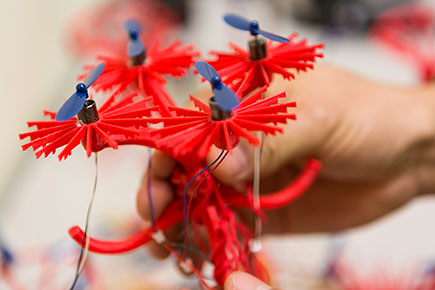Robotics and Mechatronics Research
Active-Adaptive Control in Soft-Robotic systems
What’s Involved in this Research?

This project aims to advance knowledge and develop technology for various applications that require adaptive soft robots such as in medicine, outer space exploration, communication, entertainment, and others.
We focus on active-adaptive controls as applied to dielectric-elastomer (DE)-based soft robotic systems. DEs are a type of the more general Electro-Active Polymer (DEAP) smartmaterials. EAP-based soft robots are very attractive for various reasons: (a) energy can be efficiently and readily stored in electrical form; (b) both power and information can be transferred rapidly via electrical phenomena; (c) computation using electronic means is readily available.
Robots that are soft can be very valuable and applicable in various fields. For example, they can be used to create superior prosthetics, to handle delicate items (such as eggs in a manufacturing line), or adjust to shapes and geometries that make them suitable to enter through various openings, gaps, or orifices.
Another relevant application of soft robots is in the film and entertainment industry since they can be used to mimic living organisms. However, due to their flexible nature, controlling soft robots can be very complex. Furthermore, if a soft robot is meant to imitate a living organism such as an octopus, a dog, or a Venus Flytrap, it must have intelligence integrated into it.
In essence, this requires the robotic system to possess adaption, learning, optimization, and control. Implementing those attributes requires research and engineering.
Our research group intends to advance knowledge and develop technology that provides solutions to those problems. Soft Robotics are attractive to researchers and developers due to their potential for biomimicry applications. Particularly, dielectric elastomer actuators (DEAs) have found applications in artificial muscles, soft grippers, joints, jaw muscles, tunable lenses, just to name a few.
How Students Benefit
The projects that we conduct in the soft robotic research group are relevant to modern applications.
By being involved in this project, students gain experience in real-world applications that are human-oriented. Our research group consists of a diverse set of students from various majors: mechanical and electrical engineering, mathematics, chemistry, and computer science.
Students learn how to conduct a literature review, research methods and dissemination, presentation skills, and other skills. This type of project complements the traditional classroom and helps prepare students very well for a future career in their field.
Research Professor

Dr. Hector Medina
B.S., M.S., Ph.D.
Professor of Mechanical Engineering
Google Scholar Profile
Impact on Society
The flexibility of soft robotics makes them suitable for direct interaction with biological tissue. The soft to soft interactions between a human and a soft robot are safer than with a traditional hard-surface robot. In addition, soft robots can allow the incorporation of electric and fluid conduits that render them more suitable for applications such as smart skin and clothing.
For people with fragility, tremors, or other locomotor disabilities, large-force soft robots could help restore mobility, which can have a significant impact on the quality of life of the user.
In the News
- Research Week 2020 Award Winner: Soft Robotics for Assisting People with Parkinson’s Tremor: A Proposal
- Project Dandelion in Liberty Journal
- The Dandelion Project at Liberty University
Articles
Medina H, Farmer CW. Improved Model for Conical Dielectric Elastomer Actuators With Fewer Electrical Connections. Journal of Mechanisms and Robotics. 2020 Jun 1;12(3).
Farmer C, Medina H. Dimensionless Parameter-based Numerical model for Double Conical Dielectric Elastomer Actuators. Submitted to the Journal of Smart Materials and Structures, May 2020.